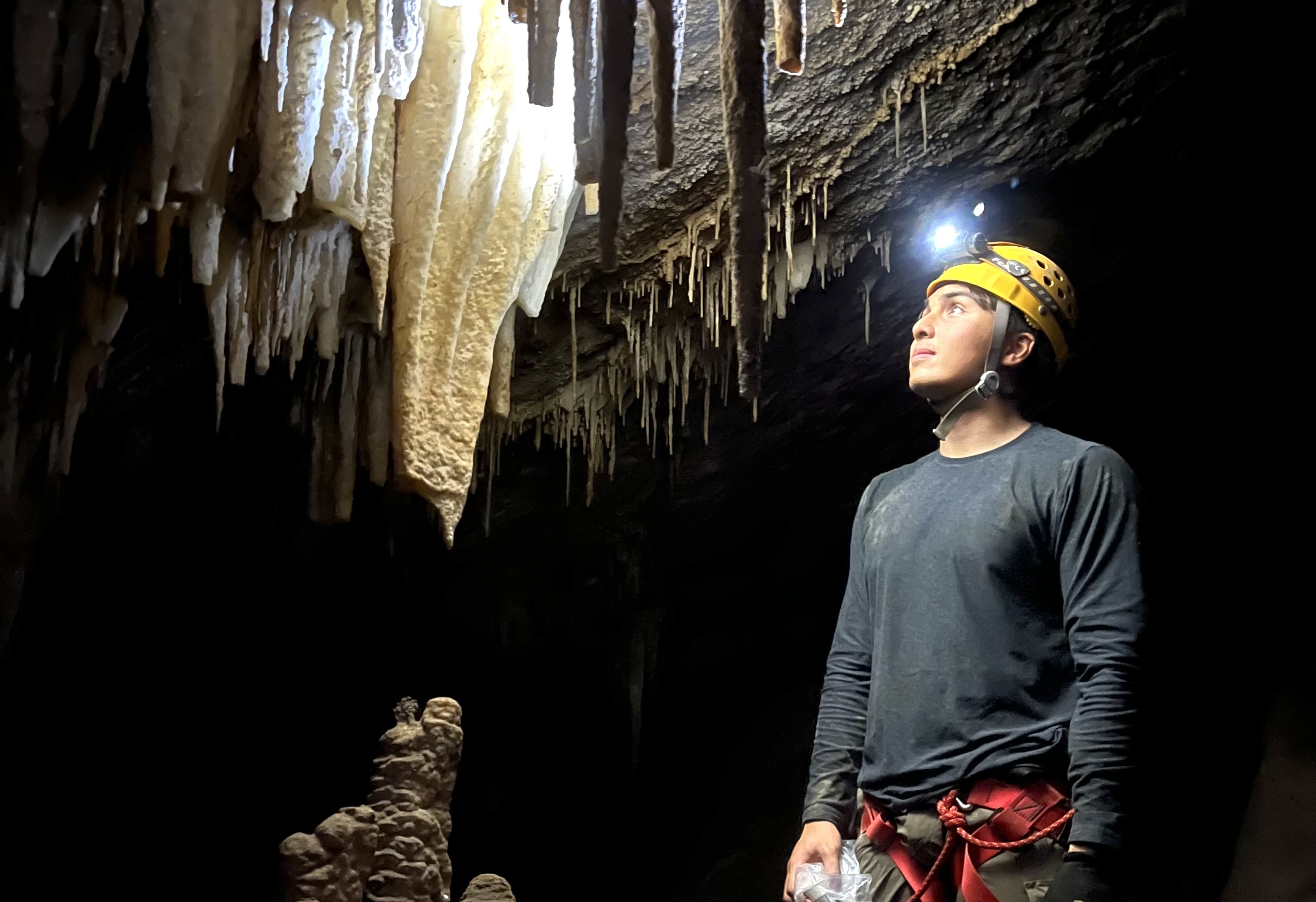Bryant Pahl wants to tell you a story

Pahl examines the cave deposits he studies in an effort to reconstruct Earth's past climate.
Bryant Pahl was nervous.
He stood by the steps leading up to a stage in a crowded room in the UC Irvine Newkirk Alumni Center, waiting for the emcee to call his name. He was at the final round of the UC Irvine heat of the UC Grad Slam science communication competition after spending countless hours prepping a three-minute pitch about his doctoral research on ancient climate change in the lab of Professor Kathleen Johnson in the UC Irvine Department of Earth System Science.
“And now, I’m honored to welcome to the stage, Bryant!” The emcee called.
Pahl straightened his tie, climbed the stairs to the stage and started his story.
“Caves,” Pahl told a hushed audience. “They’re dark, mysterious, a little bit scary and, also, Earth’s libraries…”
That was how Pahl started his tale, but the story of Pahl’s journey to that stage began a long time ago, in the high deserts of Southern California under a clear night sky.
Pahl was twelve years old, and he lived with his family in Joshua Tree, California. Pahl and his two brothers would often escape into the backyard of their home to talk and to gaze at the stars.
What he saw stood in stark contrast to the night sky in Long Beach, which is where he and his family lived before moving to the desert.
Now, far from major city lights, Pahl could see not only the stars, but also the spine of the Milky Way galaxy that arcs across clear night skies.
“I remember when I moved there, one of the first things I said was ‘What is that?’’’ Pahl remembers upon catching a glimpse of the cosmos.
It was in the silent exchange Pahl had with the stars that he made a promise to himself: he would go to college to become a scientist, something no-one in his family had ever done before.
The stars spoke to Pahl, and many years later as an undergraduate at UC Santa Barbara he started out majoring in astronomy.
Pahl took an astronomy class with Professor Robert Antonucci, and after Antonucci lectured on the Earth and climate change, he felt inspired to switch his major to geoscience.
“I was inspired by Professor Antonucci, who emphasized a chapter in our textbook about the Earth and the impact of future climate change as being the most important chapter we could take away from the class,” said Pahl, who was galvanized to share the science behind climate change with the world.
Pahl sees himself, first and foremost, as a storyteller. One of the reasons he took a path into science is the grand story he thinks the natural world must tell. For him, science is a way of translating the science of our planet into stories that resonate with others.
In 2021, Pahl became the UC Irvine School of Physical Sciences’ science communication fellow for his department, a role he used to chronicle the stories of the school’s Earth system scientists.
Long before that, Pahl discovered the power of storytelling when he was a student at UC Santa Barbara, and he found a campus-affiliated website called “Humans of UCSB.” It was a page inspired by the popular “Humans of New York,” which publishes stories about everyday New Yorkers.
“Everyone has a story, and I really believed that as an undergrad,” said Pahl. “I also believe people have a story worth telling.”
That belief inspired Pahl to approach complete strangers at UCSB so he could find out who they were. For one of his first stories, Pahl asked a manager of a campus restaurant if he could interview him.
The manager piqued Pahl’s interest because he always seemed to be in a good mood.
“What keeps that smile on your face?” Pahl remembers asking him during the interview.
The question uncorked the manager’s story, one wherein he shared being able to wake up as early as 2 a.m. each morning so he could commute to UCSB to work first as a janitor and then as the manager of the restaurant where Pahl met him.
“The reason I work so hard is for my child,” Pahl remembers the manager telling him.
Pahl witnessed the power of storytelling: after the story was published, floods of responses poured in from readers who sympathized with his tale.
In much the same way, Pahl, as a UC Irvine Earth system scientist, is working to tell our planet’s hidden stories.
“The story I’m trying to tell in my climate records is about a time when Earth was warmer than pre-industrial conditions, before humans started changing the climate,” Pahl said.
To tell that tale, Pahl travels to caves in places like Mexico so he can enter what he called Earth libraries in his Grad Slam presentation. He calls them libraries because the samples he collects consist of layers of rock that accumulated very slowly over many thousands of years.
The layers, like the pages of a book, contain chemical clues that may reveal how past periods of climate change unfolded – something that may provide clues to how modern, human-driven climate change will unfold.
“If we can observe where there are tipping points in Earth’s climate, that can inform us about what can happen to a specific region in the future,” said Pahl. “It would be good to be able to train models on better observational data. It’s about taking observations from the past to better predict how climate change will change in the future.”
Pahl’s still writing the ending of his UC Irvine story as he works to finish his doctoral research in the coming year.
But we know how the story starts: Pahl is looking at the stars that inspired him to dream about what might be possible. And, in their quiet way, the stars look back at him, wondering what will come.
